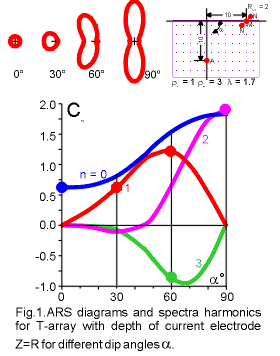 Among them
there is forward modeling for uniform anisotropic halfspace to calculate
ARS diagrams for different arrays (AM (U), AMN (E), dipole equatorial (D),
three-pole (T), Y and Arrow-type (AT) array, etc.), when source of current
is on the earth surface or at a depth. All linear arrays (AM, AMN, dipole
axial) give anisotropy ellipses with axis ratio equal to anisotropy coefficient,
while non-linear arrays (D and others) have this ratio equal to anisotropy
coefficient in the 5-th power. On fig.1 the influence of different harmonics
on the form of ARS diagram for T-array when current source is at the
depth has shown. When anisotropy is oriented horisontally, only zero
harmonic exists and we have round diagram. When anisotropy is inclined
at 30°, the first harmonic adds to the zero one and dismisses diagram
from its center. When dip angle is equal to 60° two odd harmonics (first
and third) are appriximately equal and ARS diagram has form of sicle. At
90° the second harmonic is the most intensive while odd harmonics are
equal to zero and ARS diagram has its traditional view.
Among them
there is forward modeling for uniform anisotropic halfspace to calculate
ARS diagrams for different arrays (AM (U), AMN (E), dipole equatorial (D),
three-pole (T), Y and Arrow-type (AT) array, etc.), when source of current
is on the earth surface or at a depth. All linear arrays (AM, AMN, dipole
axial) give anisotropy ellipses with axis ratio equal to anisotropy coefficient,
while non-linear arrays (D and others) have this ratio equal to anisotropy
coefficient in the 5-th power. On fig.1 the influence of different harmonics
on the form of ARS diagram for T-array when current source is at the
depth has shown. When anisotropy is oriented horisontally, only zero
harmonic exists and we have round diagram. When anisotropy is inclined
at 30°, the first harmonic adds to the zero one and dismisses diagram
from its center. When dip angle is equal to 60° two odd harmonics (first
and third) are appriximately equal and ARS diagram has form of sicle. At
90° the second harmonic is the most intensive while odd harmonics are
equal to zero and ARS diagram has its traditional view.
Forward problem for vertical contact of two anisotropic media is a good example of anisotropy and inhomogeneity combination . The decision was published in our book Electrical prospecting..., 1994. (In Russian).
Two-layered model with isotropic first layer and anisotropic basement (Bolshakov et al., 1997) has allowed to receive many new peculiarities of azimuthal soundings. The practice has shown that further development of model is required. Therefore an algorithm and program of modeling and interpretation of azimuthal resistivity sounding (ARS) data over two-layered model with arbitrary - oriented anisotropy in each layer has been developed. The decisions for such model were known earlier (Gurevich, Sagina, 1977; Ping Li et al., 1997). Our purpose was in receiving fast and effective computing algorithm, which would give precise results for any array and wide range of R/h values. The decision was published in Bolshakov et. al. at EAGE-98 Conference in Leipzig. Programs for DOS and Windows were developed.
For ARS analysis spectra of ARS diagrams' calculation was developed and realized in AnisHarm program. Spectral approach allows to calculate many useful AR diagrams' parameters, like anisotropy and asymmetry coefficients, O/E ratio (ratio of odd and even harmonics of ARS diagram's spectra), true longitudinal, transversal and mean square root resistivity, to find strike of anisotropy earth and error of its estimation, etc.
V.A. Shevnin, I.N. Modin
Tel. & fax: (7-095) 939 49 63
E-mail: sh@geophys.geol.msu.ru